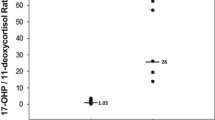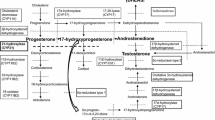Summary
Urinary excretion of total 16α-hydroxypregnenolone (16α-OH-P'O), pregnanetriol (PT), and 11-oxopregnanetriol (11-O-PT) were determined by capillary gas chromatography in 32 healthy neonates and three newborn infants with congenital adrenal hyperplasia (CAH) during the first 4 weeks of life. In the 2nd and 3rd week of life, only the 16α-OH-P'O excretion was pathognomonically elevated in infants with 21-hydroxylase deficiency. The values amounted to 1023, 1611 (age 1–2 weeks), and 2955 µg/day (3 weeks of life) compared to much lower levels in healthy peers (2nd week: mean 243, range 0–520 µg/day; 3rd week: mean 515, range 66–1541 µg/day).
Zusammenfassung
Die Ausscheidung von Gesamt-16α-Hydroxypregnenolon (16α-OH-P'O), Pregnantriol (PT) and 11-Ketopregnantriol (11-O-PT) im 24 h-Harn wurde bei 32 gesunden Neugeborenen und 3 Neugeborenen mit adrenogenitalem Syndrom untersucht. Der Beobachtungszeitraum erstreckte sich über die ersten 4 Lebenswochen. Die Bestimmung der Steroide erfolgte mittels Kapillarsäulengaschromatographie. In der zweiten und dritten Lebenswoche war bei den Patienten mit 21-Hydroxylasemangel lediglich 16α-OH-P'O im Urin pathognomonisch vermehrt nachweisbar. Die Werte betrugen 1023, 1611 (Alter 1–2 Wochen) und 2955 (Alter 3 Wochen) µg/Tag und standen damit im Gegensatz zu den wesentlich niedrigeren Mengen bei normalen Vergleichskindern (2. Lebenswoche: Mittelwert 243, Bereich: 0–520 µg/Tag; 3. Lebenswoche: Mittelwert 515, Bereich: 66–1541 µg/Tag).
Similar content being viewed by others
References
Baillie TA, Brooks CJW, Chambaz EM, Glass RC, Madani C (1974) Comparison of isopentyloxime and benzoxyme trimethylsilyl ethers in the characterization of urinary steroids of newborn infants. In: Frigerio A, Castagnoli N (eds) Mass spectrometry in biochemistry and medicine. Raven, New York, pp 335–348
Bongiovanni AM, Kellenbenz G (1962) The adrenogenital syndrome with deficiency of 3β-hydroxysteroid dehydrogenase. J Clin Invest 41:2086–2092
Bradlow HL (1968) Extraction of steroid conjugates with a neutral resin. Steroids 11:265–272
Clayton BE (1970) Diagnosis and management of congenital adrenal hyperplasia. Proc Roy Soc Med 63:1042–1044
Desgres J, Bègue RJ, Curie G, Nivelon JL, Padieu P (1974) Identification and quantitative assay of steroids in congenital corticoadrenal hyperplasia in newborn infants by gas-liquid chromatography and gas chromatography-mass spectrometry. In: Frigerio A, Castagnoli N (eds) Mass spectrometry in biochemistry and medicine. Raven, New York, pp 349–359
Hughes IA, Winter JSD (1976) The application of a serum 17-OH-progesterone radioimmunoassay to the diagnosis and management of congenital adrenal hyperplasia. J Pediatr 88:766–773
Novotny M, Zlatkis A (1970) High resolution chromatographic separation of steroids with open tubular glass columns. J Chromatogr Sci 8:346–350
Pfaffenberger CD, Horning EC (1975) High resolution biomedical gas chromatography. Determination of human urinary steroid metabolites using open glass tubular capillary columns. J Chromatogr 112:581–594
Reynolds JW (1963) Isolation of 16-OH-pregnenolone from urine of newborn infants. Proc Soc Exp Biol Med 113:980–983
Shackleton CHL, Mitchell FL, Farquhar JW (1972) Difficulties in the diagnosis of the adrenogenital syndrome in infancy. Pediatrics 49:198–205
Shackleton CHL (1976) Congenital adrenal hyperplasia caused by defect in steroid 21-hydroxylase. Establishment of definitive urinary steroid excretion pattern during first weeks of life. Clin Chim Acta 67:287–298
Schindler AE, Wuchter J, Hoppen H-O, Siekmann L (1974) Steroids in urine of the newborn human. J Clin Endocrinol Metab 39:334–339
Wilkins L (1965) The diagnosis and treatment of endocrine disorders in childhood and adolescence, 3rd edn. Thomas Springfield, Illinois, p 412
Winter JSD, Hughes IA, Reyes FI, Faiman C (1976) Pituitary gonadal relations in infancy. II. Patterns of serum gonadal steroid concentrations in man from birth to two years of age. J Clin Endocrinol Metab 42:679–686
Youssefnejadin E, David R (1975) Early diagnosis of congenital adrenal hyperplasia by measurement of 17-hydroxyprogesterone. Clin Endocrinol 4:451–454
Author information
Authors and Affiliations
Additional information
Supported by DFG, SFB 87, project C 3
Rights and permissions
About this article
Cite this article
Homoki, J., Teller, W.M. Increased urinary excretion of total 16α-hydroxypregnenolone in newborn infants with congenital adrenal hyperplasia due to 21-hydroxylase deficiency. Klin Wochenschr 60, 407–410 (1982). https://doi.org/10.1007/BF01735932
Received:
Accepted:
Issue Date:
DOI: https://doi.org/10.1007/BF01735932




